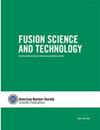Interaction of the Substance of the Tsarev Meteorite with Radiation from a Powerful Gyrotron: Dusty Plasma Cloud Formation and Phase Transformations
IF 1.2
4区 工程技术
Q3 NUCLEAR SCIENCE & TECHNOLOGY
引用次数: 0
Abstract
AbstractA new approach for simulation of the interaction of space and lunar dust with the surface of spacecrafts has been proposed. The approach is based on creating a dusty plasma cloud when the substance imitating the space or lunar dust is treated with high-power pulsed microwave radiation in the developed experimental facility. The facility consists of a high-power gyrotron (75 GHz, 0.8 MW); a plasma-chemical reactor; and a diagnostic complex, which includes optical emission spectrometers and a high-speed camera. The approach has been tested using the substance of the Tsarev meteorite, which represents a typical substance of meteorites. It was found that the substance mainly keeps the phase composition; however, the particles change their morphology due to rapid heating and melting.Keywords: Plasmaspace dustlunar dustsimulationmicrowave Disclosure StatementNo potential conflict of interest was reported by the author(s).Supplementary MaterialSupplemental data for this article can be accessed online at https://doi.org/10.1080/15361055.2023.2250669.Additional informationFundingThis work is supported by the Ministry of Science and Higher Education of the Russian Federation, project FEUZ-2023-0014.察雷夫陨石物质与强大回旋加速器辐射的相互作用:尘埃等离子体云的形成和相变
摘要提出了一种模拟空间和月球尘埃与航天器表面相互作用的新方法。该方法的基础是,在先进的实验设备中,用高功率脉冲微波辐射处理模拟太空或月球尘埃的物质,产生尘埃等离子云。该设施包括一个高功率回旋管(75 GHz, 0.8 MW);等离子体化学反应器;还有一个诊断综合体,包括光学发射光谱仪和高速摄像机。这种方法已经用Tsarev陨石的物质进行了测试,它代表了一种典型的陨石物质。发现该物质主要保持相组成不变;然而,由于快速加热和熔化,颗粒改变了它们的形态。关键词:等离子体空间尘埃月球尘埃模拟微波披露声明作者未报告潜在利益冲突。本文的补充资料可在https://doi.org/10.1080/15361055.2023.2250669.Additional info网站上获得。本文由俄罗斯联邦科学和高等教育部资助,项目FEUZ-2023-0014。
本文章由计算机程序翻译,如有差异,请以英文原文为准。
求助全文
约1分钟内获得全文
求助全文
来源期刊

Fusion Science and Technology
工程技术-核科学技术
CiteScore
2.00
自引率
11.10%
发文量
60
审稿时长
3 months
期刊介绍:
Fusion Science and Technology, a research journal of the American Nuclear Society, publishes original research and review papers on fusion plasma physics and plasma engineering, fusion nuclear technology and materials science, fusion plasma enabling science technology, fusion applications, and fusion design and systems studies.
 求助内容:
求助内容: 应助结果提醒方式:
应助结果提醒方式:


